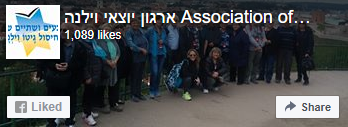Segalson, Arie, "In the Heart of Darkness - The Destruction of Jewish Kovno," 2003
Arie Segalson was an 18-year-old member of Betar when his family was imprisoned in the ghetto with all the Jews of Kovno. Luckily, he was among the few who managed to get a job that gave him some chance of surviving. The Segalsons were employed by German government institutions and were close to the Judenrat and Dr. Elhanan Elkes, who headed it. Thanks to this fact, Arie Segelson's personal memoir is in fact a chronicle of the utmost importance. Segalson paints a credible picture of Jewish life in the Kovno ghetto, documents of murders committed in the various garrisons near the city and depicts the figures of German government officials and their human weaknesses, their animal-like cruelty and their compassion, after the ghetto was liquidated. After the liquidation of the ghetto and the burning down of hiding places, the family members were marched into Germany, and their experiences is a chronicle of miracles and resourcefulness. At the end of the war, everyone united and made aliyah to Eretz Israel. Arie Segalson became a judge in Israel and served for many years in the Tel Aviv District Court.
From: Bookmark.
Dina Porat "In times of disaster, the Israeli community needed a leader," Haaretz, June 21, 2004
The memoirs of Arie Segalson, a survivor of the Kovno ghetto in Lithuania, join a long line of studies and memoirs documenting and commemorating Lithuanian Jewry before the Holocaust, and their stories: The memoirs comprise the stories of a quarter of a million Jews, that made up a rich, diverse and unique culture. The mass murder of these Jews began a few days after the German invasion of the Soviet Union, June 1941. This course of events sharply raises basic questions: When did the Jews, in the ghettos built by the Germans that summer, actually realized what the German's real intentions were? When did the Jewish leadership grasp the situation, and from that moment on, how could it have preserved the life of the Jews in the ghetto?
Comparison between the studies and the memoirs of the survivors brings up an interesting phenomenon: The conclusion of most of the researchers who studied the writings of those who wrote the memoirs, is that there was an atmosphere of public responsibility in this ghetto, and that the heads of the Jewish Council, as well as the police chiefs who persisted in their role until the ghetto was liquidated - a rare phenomenon in the history of the ghettos - were people of stature, who took into consideration the benefit to their community, and not how it could benefit them personally. However, the survivors make serious allegations, mainly about how the latter gave preference to their relatives when it came to the sustenance of everyday life, and the nature of the decisions made by the Jewish Council when the Germans made their demands.
Segalson served as a judge in Israel for several decades, and the writing of his memoirs was influenced by his profession. He describes his experiences and those of his family, while at the same time devoting a considerable part of his book to a discussion of the morality of the ghetto leadership. "From the perspective of decades that have passed since then, it is imperative to answer the question (as regards the leadership's decisions) and this should no longer be avoided" (p. 121).
Indeed, Segalson tries to judge the ghetto leadership, and in many passages in his book he accuses it of anesthetizing the vigilance of the inhabitants and carrying out the orders of the Germans. And yet, and perhaps without giving his opinion on it, his harsh judgment is mixed with passion; he blames and withdraws, states and repents what he states, and precisely from this, a complex and intertwined depiction of human stories emerges that grabs the reader.
Describing the establishment of a Jewish committee in the days before the ghetto was established, and he, an 18-year-old boy, volunteering to be active in it, he says: "It was necessary to establish some kind of organizing body among the Jews" (p. 41), to navigate the turmoil of the first days of the German's occupation. When it comes to electing members of the Jewish Council (or Council of the Elders [Altestenrat]), he describes how they were elected by the Jews (p. 55), and a few dozen pages later (p. 84), argues that the Germans were the ones who appointed its members, and therefore relied on them not to preach rebellion.
And perhaps the writer was simply wrong here, since all the sources, and in general, the survivors present at the election, are unanimous that they were elected by community representatives. In any case, he believes that the Council was set up to cooperate with the Germans to help them carry out their policy, which began with forced labor and ended with physical liquidation (p. 55), and does not mention that in difficult times like the building of the ghetto, it was necessary to establish an organizational body from among the Jews, even if the Germans had other intentions.
The author often uses the term "in good faith": For the first time, in August 1941, he attributes this term to the members of the Council (p. 84), because they still did not know what would be the result of filling out work lists for the Germans. In September, when certificates were required to be distributed but only to skilled workers, he agrees that no one in the ghetto knew what these certificates meant, but doubts the aim of this distribution, if indeed it was to be distributed only to skilled workers (pp. 102-103). In October, he presents the Council's hesitations whether to publish a notice calling on Jews to come to the square, and again says that "there is no question as to the good faith" of the members of this Council who decided that this notice should be published, because otherwise, the small chance of saving someone (from what turned out in retrospect to be the most horrible Aktion in the history of the ghetto), would be lost (p. 124).
In February 1942, he already denounces the "bad faith" involved in the preparation of these work lists (pp. 173-175), and in October 1943, after a period of relative silence of about a year and a half, denounces the preparation of another list, and in retrospect, clearly expressed his opinion that they had been constantly acting in 'bad faith': In this case and in the previous cases, the Council should have told the Germans to publish these notices and recruit the workers themselves (p. 316). He does not write that he should have known that such a refusal would have meant the immediate execution of the Council, as had happened elsewhere.
As the book draws to a close, however, he writes that Dr. Elhanan Elkes, Chairman of the Council, was "the supreme moral authority in these difficult days" (pp. 430-431), who demanded that the remnants of his community be proud of their Judaism until the last minute, as they stood at the gates of Dachau; and if sentenced to die to do so honorably and with pride; and in these words, stated "I say farewell to the Jews of Kovno who gave me full confidence in these three years of service as the head of the Council of Elders" (Judenrat) (p. 44). With similar appreciation, he writes about Elkes' deputy, Leib Garfunkel, about Dr. Yitzhak Rabinowitz, who held the impossible position of director of the Labor Department, the Council's secretary, Avraham Golov (later Tory) who bravely ran during the great Aktion to save Jews even if only a few, and about 140 Jewish policemen who were tortured at the Ninth Fort, the prison and the nearby killing site, to force them to disclose children's hiding places. Most of them endured torture even when dozens of them were executed; and as the Germans pricked out the eyes of one of the commanders, he spat on them and called on his policemen not to surrender or disclose. Segalson counted one by one the names of the ten policemen who were broken, as if he had prosecuted them retrospectively (p. 292).
Moreover, in the last days of July 1944, his uncle, Moshe Segalson, also a revered figure in the ghetto, refused to save himself, and after speaking with Dr. Elkes, he rejected an offer to flee and thus endanger the workers in the workshops he managed. In those very last days of the ghetto, the uncle made a list of one hundred men tasked with dismantling the workshops and bring the equipment and raw materials to Germany, and the author does not hide from his readers neither the making of the list nor how he felt, sixty years ago, when he saw that all his family members were included on the list; and perhaps did not feel the conflict between his feelings then, and the scathing criticism of the Jewish Council and its lists.
Yet Segalson writes about the corruption of the ghetto's leadership (pp. 103,111), and of the decadent life of a friend (p.99), as if, under the given condition, it was not possible to call upon favoritism, or put one's relatives on "good" lists, or those contemptible informers who embittered the life of Council members and the life of the ghetto in general. But Segalson also asks the reader to judge him. He writes in great detail and precision, as if out of a duty to paint a picture true to reality, and does not attribute to himself good deeds he did not do, or attributes to himself an important position he did not have.
He tells candidly about his family's affluence, about the "good" job he received - registering and sorting property looted from the Jews - and a permit allowing him to leave town; and with the same frankness, tells of an Aktion during which he fled into hiding leaving his father behind, and feels that he betrayed him (p. 77), and of thoughts of escape that were a sin in his eyes: the deep connection that bound his family to each other - a very Zionist family very proud of its Judaism – where respect for one's father and mother and of the values of tradition were self-evident - did not allow self-rescue, just as collective responsibility did not allow any hasty action in the ghetto at all (p. 397).
It is difficult to put the book down in spite of its length (there are 1,500 pages originally, written in the last six years, along with the work of editing), also because of the vivid and sincere picture emerging from it, and as a gesture of respect for the author, with whom the reader empathizes and marvels at the forces needed to withstand another illusion and disappointment, more hope and despair - and must continue to the end of the saga, after more camps and death marches - until making aliyah. Would the fate of the Kovno ghetto have been different from that of others if its leadership had been as spiritually pure as Joseph's coat? The judge does not really rule on this question, but discusses the internal Jewish dilemma regarding the standing of elected officials in an unprecedented reality, and brings the reader to the opposite conclusion from the one he opened: they stood the test, and most of those who survived were chosen to serve in the institutions of the remaining survivors- but their fate was the same.


